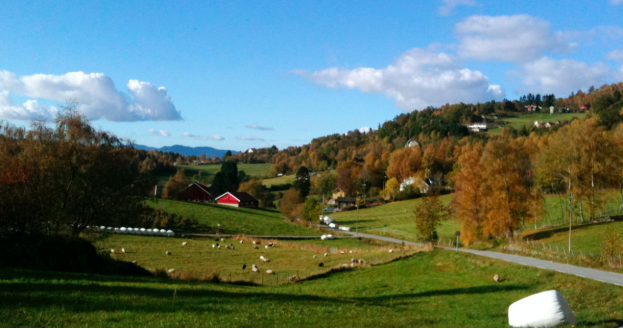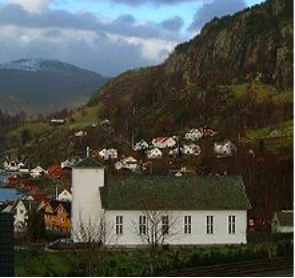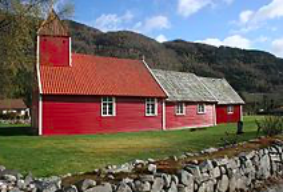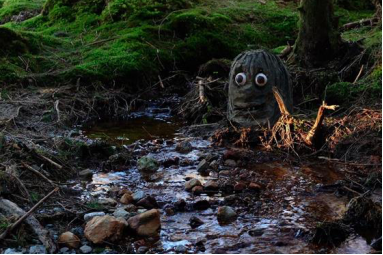Hjelmeland 作者: 来源: 发布时间:2021-04-22
一、所属省或是州,具体位置,人口,面积
Hjelmeland is a municipality in Rogaland county, Norway. It is located in the traditional district of Ryfylke. The administrative center of the municipality is the village of Hjelmelandsvågen. Other villages in the municipality include Fister, Årdal, and Jøsenfjorden.
Hjelmeland is known for its fruit (apples, pears, plums, cherries and strawberries) and fish production. Salmon has been important for the fish industry in Hjelmeland for a couple of decades, but white fish such as cod and halibut has increased its value in the latter years.
The 1,068-square-kilometer (412 sq mi) municipality is the 105th largest by area out of the 356 municipalities in Norway. Hjelmeland is the 248th most populous municipality in Norway with a population of 2,574. The municipality's population density is 2.7 inhabitants per square kilometer (7.0 / sq mi) and its population has decreased by 6.2% over the previous 10-year period.

二、自然地理
1.地理条件
The municipality stretches from the mountains bordering the Setesdal valley to the shores of the fjords that connect to the main Boknafjorden. The small Jøsenfjorden and Årdalsfjorden cut into the mainland. There are several islands that are part of Hjelmeland including Randøy as well as some smaller surrounding islands. The island of Randøy is connected to the mainland by the Randøy Bridge.
There are several large lakes in the municipality including Nilsebuvatnet, Øvre Tysdalsvatnet, and Tysdalsvatnet. The large lake Blåsjø partially lies in the municipality. The Trollgarden glacial moraine lies atop a mountain in Hjelmeland. The Ritland crater is also located in the municipality.
2.交通情况
Randøy Bridge is a suspension bridge in Hjelmeland municipality in Rogaland county, Norway. The bridge crosses the Ølesundet strait and links the island of Randøy to the mainland. The bridge has a main span of 202 meters (663 ft). The bridge opened in 1976 as part of County Road Fv650. The bridge is located 4.5 kilometers (2.8 mi) southwest of the village of Hjelmelandsvågen and about the same distance northeast of the village of Fister.
The most important traffic artery is Riksveg 13, which runs through most of the municipality from the municipal border to Strand in the south and to Suldal in the north. Most of the villages in Hjelmeland are connected to this road which provides a connection to Stavanger through a ferry connection from Tau. The ferry connection will be replaced with a 24 kilometer long tunnel - Ryfast - which is expected to be completed in 2019. Highway 13 crosses the Jøsenfjord by ferry and there have been plans for a tunnel here as well (Jøsenfast), but such a project is many years ahead. A number of the old scheduled boat quays are still in use for passenger traffic with fast boats to and from Stavanger. Otherwise, some daily bus connections between Hjelmelandsvågen and Tau are the only public transport service.
三、经济发展和规模
Traditionally, agriculture and fruit growing have been the most important industries in the municipality, but there are also a number of other activities. In Årdal, the company Norstone operates a large sand mine with exports to several countries. Sand is collected from several places in the village, and it is sorted and cleaned at a separate facility on Svadberg before it is loaded on ships and exported. Sand roofs of smaller dimensions are found in Tøtlandsvik and Jøsenfjorden.
At Hundsnes, Marine Harvest has a salmon slaughterhouse and a number of trailers of fresh salmon go daily from here to the markets in Europe. Marine Harvest has also succeeded in commercial halibut farming in the nearby Jøsenfjord. And at Jøsneset, Mikals Laks smokes salmon.
The traditional jær chairs also come from Hjelmeland - the name is due to the fact that the seats were previously braided from reeds from Jæren. The only two manufacturers of these chairs - Slåke Trevarefabrikk and Aksel Hansson AS - are both located in Hjelmelandsvågen. On Randøy there was previously (approx. 1900) a large slate slab quarry and from this some building stone is still extracted, but to a lesser extent.
Net operating profit is positive by NOK 11.67 million. Restricted operating funds have increased by NOK 4.4 million, this is mainly the power fund. Kraftfondet has a balance per. 31.12.2019 at NOK 20.78 mill.
In relation to the accounts for 2018, there has been a reduction in operating revenues of NOK 2.3 million, this is due to several items on the revenue side, but it is worth noting that the tax revenue on income and assets does not increase from 2018 to 2019. For operating expenses there is an increase of NOK 16.4 million. Gross operating profit is positive by NOK 5.0 million, against the budgeted NOK -6.56 million.
Net operating profit is NOK 11.67 million, which is 3.5% of total operating revenues. Budgeted net operating profit is NOK -0.7 million. This shows that Hjelmeland municipality in 2019 has a net operating profit that is about NOK 12.3 million better than budgeted.
The surplus after mandatory provisions is NOK 6.43 million, against an original budgeted result after provisions of NOK 1.6 million (budgeted as a provision for available funds).
The result in Hjelmeland for 2019 shows a fairly stable operation, even though it is a weaker result than in 2018.
In that sense, the 2018 accounts were probably extraordinary with high to high revenues from the Aquaculture Fund. 2019 is better than budgeted and is better than it has been outlined in the financial period.
https://www.hjelmeland.kommune.no/tenester/planar-og-kunngjeringar/planar-og-styringsdokument/
https://innsyn.onacos.no/hjelmeland/wfinnsyn.ashx?response=journalpost_detaljer&journalpostid=2020006599&
https://innsyn.onacos.no/hjelmeland/wfdocument.ashx?journalpostid=2020006599&dokid=357145&versjon=1&variant=A&
四、产业特点重点项目
The most important strategic choice then was that the municipal council decided that both the community part and the area part of the municipal plan should be revised. This work will start in the autumn of 2016, and the final plan was approved in April and October 2019 after three years of intense work. Some other planning work was also prioritized, but not everything was done. This is partly due to the fact that new tasks came up, that the municipal planning work was very extensive, that other important planning tasks came about (especially regulatory work related to double ferry quays with hydrogen solutions), but also that the planning strategy was not always given equal weight both politically and in the organization.
1.2 Legal basis: plan and the Building Act, Chapter 10
The legal text reads:
The municipal council shall at least once in each election period, and no later than within one year after constitution, prepare and adopt a municipal planning strategy. The planning strategy should include a discussion of the municipality's strategic choices related to community development, including long-term land use, environmental challenges, the sectors' activities and an assessment of the municipality's planning needs during the election period.
In the work with municipal planning strategy, the municipality shall obtain views from state and regional bodies and neighboring municipalities. The municipality should also set up broad participation and public debate as a basis for the treatment. Proposals for decisions in the municipal council shall be made public at least 30 days before the municipal council's consideration.
During the consideration, the municipal council shall decide whether the current municipal plan or parts of it shall be revised, or whether the plan shall be continued without changes. The municipal council can then decide whether there is a need to initiate work on new area plans during the election period, or whether current plans should be revised or revoked.
The preparation and processing of a municipal planning strategy can be merged with and be part of the start of work on the municipal plan, cf. Chapter 11.
1.3 Corona outbreak in the spring of 2020
The worldwide virus epidemic that started in Wuhan Province in China in December 2019, reached northern Italy in late February. Many Norwegian ski tourists were inadvertently involved in bringing the infection home to Norway, and from 13 March the community was "shut down". This came on incredibly suddenly, and within a few days the world was seen completely "upside down" both locally and globally. The schools were closed, and all events canceled. Strong restrictions were introduced on travel activities, and the Infection Control Act was actively used. How this crisis develops further will have a major impact on society in the next few years, and makes planning based on what we saw for ourselves last year, almost impossible. Not only because of the disease itself, but especially because of the ripple effects that we do not know enough about today. When society stops, so does much of the business community, something that has major financial consequences.
The corona situation emerged in the final phase of the preparation of this document, and one has therefore to a very limited extent taken into account the new moments that this entails.
https://www.hjelmeland.kommune.no/tenester/planar-og-kunngjeringar/kommuneplan-2019-2031/
https://www.hjelmeland.kommune.no/tenester/planar-og-kunngjeringar/kommunal-planstrategi/
五、风景名胜,景点( attractions)
1. Hjelmeland Church

Hjelmeland Church (Norwegian: Hjelmeland kirke) is a parish church of the Church of Norway in Hjelmeland Municipality in Rogaland county, Norway. It is located in the village of Hjelmelandsvågen. It is the church for the Hjelmeland parish which is part of the Ryfylke prosti (deanery) in the Diocese of Stavanger. The white, wooden church was built in a long church design in 1858 using designs by the architect Hans Linstow. The church seats about 500 people.
The earliest existing historical records of the church date back to the year 1280, but the church was probably built during the 12th century. Originally, the stave church was located at Sæbø on an island in the estuary of a small river, about 125 meters (410 ft) northwest of the present site of the church in Hjelmeland.
The church was then known as Sæbø Church and the priest had a farm, just south of the river in Hjelmeland. Over time the names Sæbø and Hjelmeland were used interchangeably for the church and parish. In the years 1618-28, a number of construction works were carried out on the church, including the erection of a new tower. Also, a new and larger nave was added to the west. In 1858, a new church was built about 125 meters (410 ft) to the southeast across the river on the site of the priest's farm. The new church was known as Hjelmeland Church, after the name of the farm on which it was located. The old church was torn down soon afterwards.
2.ld Årdal Church

ld Årdal Church (Norwegian: Årdal gamle kirke) is a historic parish church of the Church of Norway in Hjelmeland Municipality in Rogaland county, Norway. It is located in the village of Årdal. It used to be the church for the Årdal parish (but now it is rarely used) which is part of the Ryfylke prosti (deanery) in the Diocese of Stavanger. The red, wooden church was built in a long church design in 1620 using designs by an unknown architect. The church seats about 175 people.
The earliest existing historical records of the church date back to the year 1308, but the stave church was probably built during the 13th century. The church was torn down in 1619 and a new church was built on the same site. The new church was consecrated in 1620. The new building was constructed using some of the reused materials from the previous church on the same general site. Part of the foundation under the southwest corner of the church was the same foundation for the medieval stave church.
The church served this area from its completion date in 1620 until 1919 when the new Årdal Church was completed about 600 meters (2,000 ft) to the southwest. Since that time, the old church has no longer been used regularly, but it has been used for special occasions such as weddings and concerts. There are still two regularly scheduled worship services held at the church each year, one service on Olsok and one other Sunday morning in the summer. The interior of the church is decorated with hand-painted rosemåling.
3. Lappeenranta harbor

The fairytale forest is an exercise track for your senses. Do not fly away with a high pulse and a sweaty forehead. No, through the Fairytale Forest you should take it easy so that your senses can come to life - the senses you may have had as a child, but which have fallen asleep over the years.
The path you walk through the forest was in the old days the link between the village and the mountains. But in recent years there has been little traffic here - one can talk about untouched nature. And just like that, I want it to continue to be. Therefore, we will greatly appreciate that eager children's feet as far as possible follow the path and look at the figures from this, so that moss and lichen are not damaged and the forest is allowed to show you the magic that lies in untouched nature.
Drive towards the church in Årdal from national road 13 and follow the signs to Eventyrskogen. For those who are locally known, Eventyrskogen is located in Bønardalen, past the Dalane construction site in Årdal.
https://www.hjelmeland.kommune.no/tenester/kultur-idrett-og-fritid/friluftsliv/turomrader/eventyrskogen/
六、历史文化
1.历史
Hjelmeland was established as a municipality on 1 January 1838 (see formannskapsdistrikt law). In 1859, Hjelmeland municipality was split into two: the southern portion of the municipality (population: 1,315) was split off to form the new municipality of Årdal and the remainder of the municipality became the municipality of Hjelmeland og Fister (population: 3,084). On 1 July 1884, the western islands and the western coast of the mainland (population: 832) were split off from Hjelmeland og Fister to form the new municipality of Fister and the rest of the municipality was renamed simply "Hjelmeland" which now had 2,249 residents.
During the 1960s, there were many municipal mergers across Norway due to the work of the Schei Committee. On 1 January 1965, all of Hjelemland municipality (population: 1,691) was merged with most of the municipality of Årdal (except the Sundgardene area along the Årdalsfjorden), the mainland part and the island of Randøy from the municipality of Fister, and the small Buergårdene area on Ombo from the municipality of Jelsa. The population of the newly enlarged Hjelemland was 2,909; nearly doubling the size of the municipal population. On 1 January 2020, the parts of Hjelmeland municipality that were located on the island of Ombo were transferred to the neighboring Stavanger Municipality so that the whole island would be part of the same municipality.
The municipality (originally the parish) is named after the old Hjelmeland farm (Old Norse: Hjalmaland), since the first Hjelmeland Church was built there. Today the farm is a part of the Hjelmelandsvågen urban area. The first element of the name is the plural genitive case of hjalmr which means "helmet" and this is referring to two heights behind the farm which have the form of two helmets. The last element is land which means "land" or "farm".
The coat of arms was granted on 30 November 1984. The arms show a six yellow woven straws on a red background. They are based on the local tradition of making chairs and other furniture with seats of woven twigs (jærstoler). The process of weaving is symbolized in the arms. At the same time the arms show the strength and solidarity of the municipality.
2. 文化体育
The municipality's millennium site is an outdoor stage in the yard in Hjelmelandsvågen. When the municipality received the state support, they were earmarked for the Vågen area. The outdoor scene was a miss in Hjelmelandsvågen, where, among other things, the Fruit and Salmon Party is arranged every year. The stage was designed by Knut Fosså, and the stone used comes from Randøy.
We have many different voluntary teams and organizations in the municipality, and a large part of these have activities for children and young people. Hjelmeland Theater has children's theater, On the Facebook page of Hjelmeland IL football, you will find various information about training, matches, cups and other fun! One club meeting per. month. Varied program with outdoor life, hiking, club activities and social activities. A quarter of the members choose a project they want to work on throughout the year, and this ends in October / November with an autumn party and distribution of badges / assessment cards. Hjelmeland Samfunnshus arranges a youth club for young people aged 13-18, about 1 gong per month.
The leisure card provides free admission to a number of events and activities. It also offers free membership with a couple of players.
https://www.hjelmeland.kommune.no/tenester/kultur-idrett-og-fritid/idrett-og-fritid/fritidsaktivitetar/
https://www.hjelmeland.kommune.no/tenester/kultur-idrett-og-fritid/idrett-og-fritid/fritidskort/
七、其他信息
All municipalities in Norway, including Hjelmeland, are responsible for primary education (through 10th grade), outpatient health services, senior citizen services, unemployment and other social services, zoning, economic development, and municipal roads. The municipality is governed by a municipal council of elected representatives, which in turn elect a mayor. The municipality falls under the Stavanger District Court and the Gulating Court of Appeal. The municipal council (Kommunestyre) of Hjelmeland is made up of 19 representatives that are elected to four year terms.
八、联系方式
Town manager: Bjørn Laugaland
Phone:404 39 010
Address:Vågavegen 116 4130 HJELMELAND
